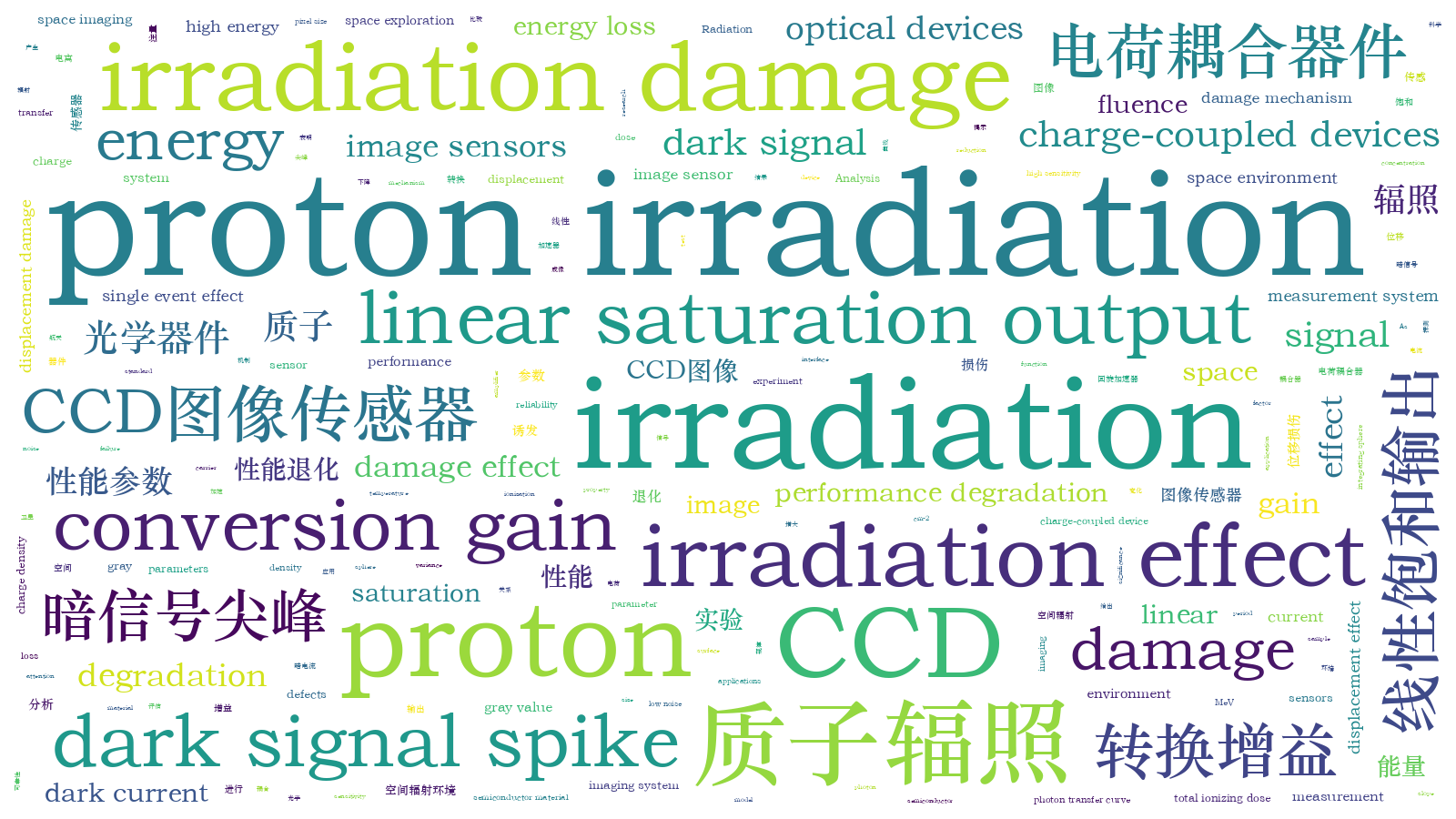不同能量质子辐照诱发CCD图像传感器性能退化实验与分析
As a photoelectric image sensor widely used in the field of aeronautics and astronautics, charge-coupled device (CCD) has attracted much attention due to its proton irradiation damage in the space environment. Performance degradation and function failure will be caused by irradiation damage when CCDs are applied to the orbiting satellite or the space imaging system. The irradiation damage effect of CCDs generally includes total ionizing dose, displacement effect, and single event effect. The total ionizing dose and displacement effect will cause permanent damage by influencing the semiconductor material in CCDs to induce oxide defects and interface defects. The single event effect will induce high charge density in the sensitive region of CCDs and disturb the output signal. The damage induced by the single event effect will be gradually recovered in the next signal transfer period. As an important factor causing CCD performance degradation in the space irradiation environment, proton irradiation damage is necessary to be studied, which is of significance to improve the reliability of CCD application in the space irradiation environment. We report the proton irradiation experiments of CCDs with different energy and fluence on proton cyclotrons. The degradation of CCD property parameters such as conversion gain, dark signal, and linear saturation output induced by proton irradiation is analyzed. We hope that our experiment and analysis can be helpful for designers to improve the reliability of CCD applications in space irradiation environments such as space exploration and satellite imaging.
CCD proton irradiation experiments with proton energy of 60 MeV and 100 MeV are carried out on Xi'an 200 MeV Proton Application Facility (XiPAF). The irradiation fluence is 1×1010, 5×1010, and 1×1011 cm-2, respectively. All pins of the CCD are offline and unbiased during irradiation. The CCD model used in this experiment is ICX285AL. The pixel size is 6.45 μm×6.45 μm, and the total number of effective pixels is 1392×1024. Its advantages of low noise and high sensitivity meet the requirements of proton irradiation experiments. The CCD parameter test is carried out on the irradiation effect parameter measurement system of photoelectric image sensors based on European standard EMVA1288. The measurement system is composed of a measurement host computer, integrating sphere, sample carrier, and darkroom. The laboratory temperature before and after irradiation is about 25 °C. In this study, the gray value of the dark field image measured in the irradiation effect measurement system of photoelectric image sensors is used as the output signal of the sensor. The value of conversion gain is calculated by the curve of variance gray value and mean gray value, and the dark field image is used to analyze the change in dark signal spike before and after irradiation.
In this study, experiments of proton irradiation of 60 MeV and 100 MeV on CCDs are carried out to analyze the experimental law of CCD performance degradation induced by proton irradiation. The CCD linear part slope of the photon transfer curve produces a certain extent of reduction because the output amplifier of CCDs can be damaged by proton irradiation, which indicates that the conversion gain of CCDs decreases along with the increase in the irradiation fluence (Fig. 3 and Fig. 4). The linear saturation output of CCDs also degrades after proton irradiation with different energy because proton irradiation produces a high concentration of oxide defects and interfacial trapped charge in the CCDs (Fig. 6). In addition, with the increase in irradiation fluence, both conversion gain and linear saturation output degrade to some extent, and proton irradiation with higher energy will induce more serious degradation of conversion gain and linear saturation output than that with lower energy (Fig. 5 and Fig. 6). The study of dark signal shows that the quantity of dark signal spike increases significantly after proton irradiation, and the density of dark signal spike increases with higher energy under irradiation (Fig. 7 and Fig. 8). The dark current of CCDs under proton irradiation raises with the increase in the irradiation fluence, which indicates that both the bulk dark current and surface dark current generated by proton irradiation cannot be ignored (Fig. 9). Furthermore, higher irradiation energy is accompanied by greater increase in dark current. The CCDs irradiated with protons produce ionizing energy loss (IEL) and non-ionizing energy loss (NIEL). The IEL and NIEL are used to evaluate proton irradiation damage of CCDs. Proton ionization damage and proton displacement damage are related to IEL and NIEL, respectively. Overall, the IEL and NIEL induced by proton irradiation of 60 MeV are greater than those induced by proton irradiation of 100 MeV.
The experiments of high energy proton irradiation of 60 MeV and 100 MeV on XiPAF are introduced in this study, and the experimental law of CCD performance degradation induced by proton irradiation is analyzed. The conversion gain, dark signal, and linear saturation output of CCDs degrade obviously, and the dark current significantly increases after proton irradiation. Under the same irradiation fluence, the degradation of conversion gain and linear saturation output induced by proton irradiation of 60 MeV is more serious than that by proton irradiation of 100 MeV, and more dark signal spikes and larger dark currents are produced. The degradation of the above parameters indicates that CCD performance will be seriously affected by proton irradiation. The results show that CCDs are very sensitive to the damage caused by proton irradiation as an image sensor working in the space environment, and the study provides a reference for the research on the damage mechanism of CCD high energy proton irradiation.
黄港, 王祖军, 吕伟, 聂栩, 赖善坤, 晏石兴, 王敏文, 卓鑫, 于俊英, 王忠明. 不同能量质子辐照诱发CCD图像传感器性能退化实验与分析[J]. 光学学报, 2023, 43(11): 1123001. Gang Huang, Zujun Wang, Lü Wei, Xu Nie, Shankun Lai, Shixing Yan, Minwen Wang, Xin Zhuo, Junying Yu, Zhongming Wang. Experiment and Analysis of Performance Degradation of CCD Image Sensors Induced by Proton Radiation with Different Energy[J]. Acta Optica Sinica, 2023, 43(11): 1123001.







